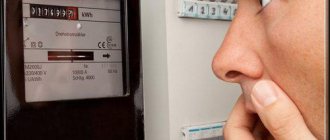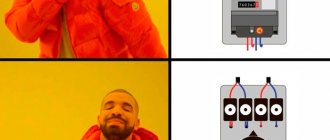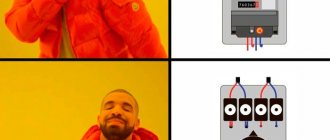The cost of electricity is constantly rising, and every time bills from energy sales companies arrive, despondency sets in. Consumers often wonder how they can legally save on electricity without paying huge sums of money. One solution to this issue is the installation of a two-tariff meter. But is this method of saving suitable for the average consumer? Is a two-tariff meter still beneficial or not?
Classification of electricity meters
Electricity metering devices differ in the number of tariff zones. Their difference is that they are divided into single-tariff and multi-tariff.
A single-tariff meter records the consumption of electrical energy around the clock at one tariff.
In turn, multi-tariff electricity meters are divided into subtypes:
- accounting for two zones (two tariffs): day (peak) zone T1 and night T2;
- accounting for three zones (three tariffs): peak zone T1, half-peak zone T2 and night T3;
- metering in four zones (four tariffs): designed for metering electricity of large enterprises.
A multi-tariff meter records the volume of electricity at a certain time of day (zones). In Russia, no more than three tariffs are accounted for.
How to take readings and pay
Some modern multi-tariff electricity meters have the function of automatically transmitting readings to Energosbyt. Owners of such devices should not worry about timely data recording. You can only occasionally check the readings to avoid errors and arrears in paying for electricity.
Subscribers whose meter cannot automatically send data should take readings themselves between the 15th and 26th. This is done quite simply. Switching between readings of different tariff zones is most often done using the “Enter” button, but depending on the model, there may be other switching methods.
After each press, the meter display will show the readings of different tariff zones. It is important to carefully write down the data to the decimal point and calculate the amount to be paid in accordance with the cost of one kilowatt for each tariff zone.
A multi-tariff meter will allow home owners to significantly save their family budget, but only if the use of powerful household appliances is clearly planned in accordance with time zones.
Unlike using “charged” meters with a remote control, this is a legal, legal way to save money. Useful article? Rate and share with friends!
The principle of operation of a two-tariff meter
It is not difficult to understand how a two-tariff electricity meter works and what is the difference between a single-tariff and multi-tariff electricity meter. It records energy consumption in two periods: during the day from 7.00 to 23.00 and at night - from 23.00 to 7.00. This differentiated metering by zone is what distinguishes a two-tariff meter from a conventional single-tariff meter, which records data around the clock at one tariff.
Electrical energy consumed in private or apartment buildings during the day varies greatly, which can be clearly seen on the load graph of an apartment building.
An example of a daily load schedule for an apartment building.
The graph shows that at night, from approximately 1.30 to 6.00, the amount of electricity consumed is the lowest. And the peak load occurs in the evening from 18.00 to 22.00.
Such a schedule can be a strong motivation to use electrical appliances at night. Household appliances with high energy consumption (washing machine, dishwasher, electric kettle, microwave oven, iron, air conditioner) are preferably used during lower peak loads, and their use at night will allow you to save a lot of money.
Input wire
An example of connecting an input to a private house
- Although this does not directly concern the calculation of electrical wiring, still complete this step. Check the cross-section (or the sum of cross-sections, if you have several lines) of the wires after input with the cross-section of the input conductor.
- The input must either be made with a wire of a larger cross-section or be equal. If the opposite happens, then you need to reduce your appetite (the power of the appliances installed in the house), or contact the electricity supplier company.
- A situation may occur when correctly calculated internal wiring will withstand but the input will burn out. Therefore, it is necessary to increase its diameter and permissible current. This can be done by a service serving external networks.
Usually this is a paid procedure and at the same time it is necessary to renew the contract due to an increase in the limit of supplied energy.
Correct calculation of wiring will help to avoid frequent repairs.
I hope our article has fully covered the topic for you: calculating electrical wiring in a house. Even if you do not carry out this work yourself, knowing the principles will help you save money when ordering materials or services. May your home always be illuminated, comfortable and safe.
Calculation of the economic effect of switching to a two-tariff meter
Before making a decision to replace a single-tariff meter, it is advisable to calculate the efficiency of switching to a two-tariff electric meter.
Regional authorities independently determine tariffs for the supply of eclectic energy, so the cost per kilowatt-hour in each subject of the Russian Federation is different. Tariffs usually change every six months. And their changes, unfortunately, are only increasing.
As an example for calculation, you can take tariffs for the first half of 2022 in the Lipetsk region.
Single-rate tariff - 3.67 rubles. per kW/h.
Two-zone tariff:
- day - 4.22 rub. per kW/h;
- night — 2.20 rub. per kW/h.
The difference between the consumption of electrical energy during the day and at night is almost 2 times different and amounts to 2.02 rubles. per kW/h.
During the same period in the Irkutsk region, prices differ:
Single-rate tariff - 1.11 rubles. per kW/h.
Two-zone tariff:
- day - 1.27 rub. per kW/h;
- night — 0.74 rub. per kW/h.
The difference in the Irkutsk region was only 0.53 rubles. per kW/h.
Using the examples of two regions, we can conclude: in the Lipetsk region, the transition to a two-tariff meter will become feasible, but in the Irkutsk region it is practically unprofitable.
Therefore, before installing a new meter, it is worth analyzing the cost of electricity in your region, assessing the economic effect and considering whether it is profitable or not.
How to connect a three-phase meter
There are three phases in a 380 V network, and electric meters of this type differ only in the large number of contacts. The inputs and outputs of each phase and neutral are located in pairs (see the diagram). Phase A enters the first contact, its output is on the second, phase B is the input on the 3rd, its output on the 4th, etc.
How to connect a three-phase meter
The rules and procedure are the same, only there are more wires. First we clean it, align it, insert it into the contact connector and tighten it.
The connection diagram for a 3-phase meter with a consumption current of up to 100 A is almost the same: input machine-meter-RCD. The only difference is in the distribution of phases to consumers: there are single- and three-phase branches.
Three-phase meter connection diagram
Selecting a meter, its cost and installation
You can purchase an electrical energy meter at any electrical goods store. Sales consultants will tell you what a two-tariff meter is, which ones are good, and give advice on choosing an electronic device. The cost of equipment depends on the manufacturer, model, accuracy class and service life.
A brief overview of budget electronic (static) electricity meters.
| № | Name | Manufacturer country | Accuracy class | Warranty period, years | Service life, years | Average price, rub.* |
| 1 | TAIPIT NEVA MT 124 AS OR 1ph 5-60A 220V | Russia | 1 | 7 | 30 | 2660.00 |
| 2 | INCOTEX MERCURY 206 RN 1ph 5-60A 1.0/2.0 | Russia | 2 | 3 | 30 | 2400.00 |
| 3 | ENERGOMERA 459547 CE 102 R5.1 145 J 1ph 5-60A | Russia | 1 | 4 | 30 | 1550.00 |
| 4 | SOE-55/50Sh-T-112 MZEP | Russia | 1 | 3.5 | 32 | 1450.00 |
*According to the website https://lipetsk.220-volt.ru.
- TAIPIT NEVA MT 124 AS OR 1ph 5-60A 220V.
- INCOTEX MERCURY 206 RN 1ph 5-60A 1.0/2.0.
- ENERGOMERA 459547 CE 102 R5.1 145 J 1ph 5-60A
- SOE-55/50Sh-T-112 MZEP.
More expensive two-tariff meters with advanced functionality are also sold, but not always expensive ones with many functions that are much better than usual. Still, the main task of the device is to correctly record data.
Before purchasing, you should pay attention to the accuracy class, verification time and the availability of additional maintenance for a multi-tariff meter.
Types of three-tariff meters
As you know, you can install two main types of meters: induction and electronic. The former are not used as multi-zone metering devices. Electronic can be single- or three-phase. This depends on whether you are using power tools or three-phase powered appliances. In most cases, it is sufficient to use a single-phase meter.
To take readings you need to press the button
Calculation of consumed electrical energy
On average, electricity consumption in a 3-room apartment with an area of 60 sq.m per month is approximately 250–300 kW. In winter, consumption increases due to short and cold days, and in summer, on the contrary, it decreases.
Before choosing a single-tariff or two-tariff electric meter, you need to analyze the amount of electricity consumed by time of day, your daily routine, what time your working day starts and ends. If the main peak and consumer activity occurs at night, then it is better to install a two-tariff meter. With a more detailed analysis of electricity use, you can install a three-tariff electricity meter, if this is most appropriate.
The cost of installation work varies in each region. The price for the service ranges from 500 to 1500 rubles. Installing a two-tariff electricity meter is a short process, but requires high professionalism of an electrician.
Advantages and disadvantages
When using this mode, there are the following advantages:
- If the consumer uses a three-tariff meter, he will be able to distribute electricity costs in such a way that the most energy-consuming actions are performed during the period when the minimum tariff is in effect.
- Since such a counter is more expensive than a regular one, the difference in price can be compensated by saving resource consumption.
- Such an electric meter will allow you to detect attempts of unauthorized electricity withdrawal.
Such a meter helps save money.
However, the option under consideration also has disadvantages:
- Some people use almost no electricity at all. In this case, the savings will also be insignificant.
- Some people cannot handle laundry, washing, dishes or cooking at night.
- Tariffs are becoming more expensive, and the tariff for a day zone may be higher than that used for a single-tariff meter. Therefore, the transition to a new payment system in some cases may be unprofitable.
- The relatively high cost of such a metering device.
You might be interested in how the RCD works and what it is
. Important! The decision on the profitability of installing a three-tariff meter should be made taking into account the characteristics of the use of electricity and the possibilities of using the advantages of such an metering device.
Calculation of economic benefits
To calculate savings, you need to compare costs for two types of metering devices.
Example.
Consumption in winter is 300 kW per month. Tariff - 3.67 per kW/h. Thus, with a single-tariff meter installed, the consumer will have to pay for the services: 300×3.67 = 1101.00 rubles.
Consumption in winter is 300 kW per month, but 100 kW is during the day and 200 kW at night. The volume of kilowatts is calculated separately, each according to its own tariff. Day – 100×4.22=422.00 rub., night – 200×2.20=440.00 rub. The total amount for the two-tariff meter for the month will be 862.00 rubles.
Now the difference is calculated and the savings are determined: 1101.00−862.00=239.00 rub.
Over the course of a year, a larger amount comes out: 239.00×12=2868.00 rubles.
Using economic calculations as an example, it is obvious that installing a two-tariff meter allows you to save a lot of money.
Is it legal to connect independently?
It is only illegal to take electricity without metering and payment. Therefore, it is possible to correctly install the meter yourself and put it into operation by the electricity supply organization. This will take more time, but will save money on calling a specialist and paying for his services.
The device is installed in accordance with the rules for installing electrical equipment (PUE) and the declared characteristics. Reception, sealing and registration are carried out by the authorities responsible for the use of electricity. After this, the electric meter can be used.
Payback period for purchasing a new device
If you buy the cheapest device, for example, for 1450.00 rubles, then it will pay for itself in 6–7 months: 1450.00/239.00=6.07. When purchasing a more expensive device, for example, for 2660.00 rubles. — the payback period will be approximately one year: 2660.00/239.00=11.1.
If we include the cost of services for installing the device (on average 700 rubles), then the payback in the case of purchasing two meters of different prices will be:
- Let's calculate in the first case: (1450.00+700.00)/239.00=9;
- and in the second case: (2660.00+700.00)/239.00=14.
Even if you pay for the services of an installation specialist, the payback is quick and will be 9 and 14 months.
All calculations were carried out approximately, so each consumer must make an independent calculation based on his readings and the tariffs of energy sales companies.
How much electricity does the heater consume?
Very often the possibility of additional heating of the room arises. Such situations can arise during an early cold snap or when central heating fails to cope. In order to determine how profitable or unprofitable it is to use this heating method and create a comfortable atmosphere in the house, it is necessary to determine the energy consumption of the heater.
Consumption
There are many types of heaters of varying sizes and energy consumption. Let's take a closer look at the energy consumption of each individual type so that after installation your electricity bills do not become an unpleasant surprise for you:
- Fan heaters. One of the most budget-friendly heater options. Such a device has a heating element and a fan, with the help of which heat is dispersed throughout the room. Heating occurs very quickly and cools down just as quickly after switching off. Due to the design of the heater and the open location of the heating element, the composition of the air in the room changes for the worse, and therefore it is not recommended to use it on an ongoing basis and periodically ventilate the room. During use, the air dries out, and the device itself is quite noisy and can cause significant inconvenience. The heater has high power and therefore consumes a lot of electricity. Among the advantages: low price, compactness and mobility in movement.
Calculation of savings in houses with installed electric stoves
Residents of high-rise buildings do not have gas supply, since the pressure in gas pipes can only reach 10 floors. According to the plan, apartments in such houses are equipped exclusively with electric stoves.
In houses equipped with stationary electric stoves and electric heating installations, the electricity tariff is significantly lower.
Before leaving a single-tariff meter or installing a two-tariff meter, you need to understand whether this is beneficial in terms of electrifying the entire house, take this fact into account and carry out the calculation.
As an example for the calculation, we took the cost of the tariff rate for residents living in houses with installed stationary electric stoves and electric heating installations for the first half of 2022 in the Lipetsk region.
Single-rate tariff - 2.57 rubles. per kW/h.
Two-zone tariff:
- day - 2.96 rub. per kW/h;
- night — 1.54 rub. per kW/h.
Estimated consumption in winter is 300 kW per month. Single-rate tariff - 2.57 per kW/h. Thus, with a single-tariff meter, the consumer will pay for the services of energy sales companies: 300 × 2.57 = 771.00 rubles.
Consumption in winter is also 300 kW per month, but 100 kW is during the day and 200 kW at night. The volume of kilowatts is calculated at a tariff differentiated between two zones. Day – 100×2.96=296.00 rub., night – 200×1.54=308.00 rub. The total amount for a two-tariff meter per month will be 604.00 rubles.
Calculation of the difference and determination of savings: 771.00−604.00=167.00 rub. per month, and per year - 167.00 × 12 = 2004.00 rubles.
The savings are slightly lower than in houses with gasification, but over time, for example, over a year it still turns out to be quite a significant amount. In houses with built-in electric stoves, the consumer himself chooses the optimal metering tariff for him and whether the electric meter needs to be replaced.
Which electricity meter is better to install in a private house?
Let's consider what is better to choose using the example of single-phase two-tariff meters Energomera or Mercury. These are well-known brands of devices that are in high demand.
| Parameter | Mercury 230 ART-03 RN 5(7.5) A | Energy meter CE 303 R33 746-JAZ 3ph 5-100 A |
| Accuracy class | 1/0,55 | 1/1 |
| Power | Active, reactive | |
| Load | 5-7.5 A | 5-100 A |
| Frequency | 49-51 Hz | 47.5-52.5 Hz |
| Operating principle | Electronic | |
| Indications | 4 tariffs | 2 tariffs |
| Tariff control | External, internal | External |
| Phases | 3 | |
| Anti-vandal protection | Electronic seal | |
| Memory | Monthly | |
| Dimensions (mm) | 170*74*258 | 151,5*143*72,5 |
| Weight (in kg) | 1,5 | 3 |
| Housing protection | IP54 | IP50 |
| Operating temperature in degrees Celsius | -40 – +55 | -40 – +60 |
| Installation | 3 screws | DIN rail |
| Double check | 10 years | 10 years |
| Declared service life | 30 years | 30 years |
| Guarantee | 3 years | 5 and 7 years before 05/01/2019 and after |
| Addition | Reverse stopper, self-diagnosis with alerts on the monitor | Fixation of power limit for a month, notification of deviations and exceedings |
Instructions for switching to a two-tariff meter
When the decision to switch has been made, you can replace the old electric meter with a new device.
To do this, the following algorithm of actions is observed:
- Submit an application to the regional energy sales company for installation of a two-tariff meter in person, or through your personal account on the official website.
- Purchase a suitable multi-tariff meter.
- Pay for services to replace the electric meter.
- Within 10 working days, an employee of the energy sales company will come and take readings from the old meter, dismantle it, install a new one, put it into operation and seal it.
- Sign a certificate of completion of work on commissioning, a service agreement.
You can buy an electric meter directly from the energy sales company itself, which often provide this opportunity and offer two-tariff meters. It is prohibited to independently dismantle an old metering device or break seals and is punishable by a fine.
Video description
This video shows how readings are taken from the Mercury 200.02 model:
Based on user reviews, shortcomings in each meter were identified. Mercury does not have a display backlight and you have to select a large electrical box. Energomera's craftsmen note a weak point in the assembly. Owners write only about the advantages, including backlighting and the ability to take readings without voltage.
Three-tariff meter with display backlight Source alicdn.com
Features when deciding to switch to a two-tariff electricity meter
Before installing a new meter, there are a number of factors to consider:
- tariffs for the supply of electrical energy and differentiation by zone in the regions of Russia vary;
- there is no guarantee that the cost difference between the “day” and “night” time zones will not change downwards;
- the electric meter must be installed by a specialist;
- consider payback;
- apply an individual approach;
- take into account the absence of gasification when making calculations.
It is impossible to answer the question which meter is better, single-tariff, two-tariff or three-tariff. Their differences lie in the accounting of electrical energy by time of day. Each case is considered individually, since the lifestyle and daily routine, the number of residents, the presence of household appliances with high energy consumption and other factors are taken into account. Each consumer can independently carry out a simple calculation, determine what is more profitable, decide to switch to multi-tariff electricity meters and install it.
Conclusions and useful video on the topic
A look at the profitability of a two-tariff electric meter is reflected in the following video:
A two-tariff meter is not suitable for everyone. Before installing it, you need to carefully calculate all your expenses on electricity in order to understand whether it is needed or not.
There is no universal answer to the question of the advisability of installing a two-tariff metering device. Without accurate calculations of energy consumption in a specific apartment or private house, it is difficult to say in advance whether it will be profitable or not.
Do you use a two-tariff electric meter? Share your experience with other users - tell us whether using it was beneficial for you. If you are just looking at this type of counter and want to clarify a number of nuances, ask your questions in the comments block located below under this publication.
Universal diagram for connecting wires to a single-phase electric meter
The diagram looks like this:
In the diagram you can see a single-phase electric meter located in the center, on the left there is an input power cable (phase and zero), on the right there are wires going out to the load, roughly speaking, the electricity recorded by the meter already flows through them, which through the protective automatics goes to your sockets , lamps, etc.
Cable calculation
You need to know what cross-section is needed for 15 kW and 380 for input into the house, since with an aluminum and copper core it has different characteristics, and also differs with different connection methods. For open introduction at a voltage of 380 V and a power of 15 kW, a copper conductor with a cross-section of 4 mm² and capable of withstanding a current of 41 A is required, and for an aluminum wire - from 10 mm² and a current of 60 A.
For cables laid in a pipe, copper conductors must have a cross-section of 10 mm², and for aluminum conductors - from 16 mm². The length of the cable depends on the distance of the entry point to the pole, as well as the presence of additional fasteners or supports.
First of all, the wire is connected to the electricity meter Source i.ytimg.com
Connection nuances and safety precautions
You cannot replace a double-pole circuit breaker with two single-pole circuit breakers. If there are several load lines installed after the electricity meter that have protection, the installation of a common protection device is not required.
The wires are secured so that the insulation does not fall under the pressure plate. Also, the exposed part should not protrude from under it. If the panel does not have a DIN rail, you can purchase and install it yourself.
When connecting electrical devices yourself, you must follow the following safety rules:
- The meter and machines, as well as all electrical equipment, are connected when the voltage is turned off.
- The input power cable is connected last. First, load devices are connected to the panel.
- The devices are connected according to the diagram, taking into account the colors of the wires.
- The diameter of the wire between the input and load circuit breakers must be larger than that of the input and distribution cables throughout the room.
- In order to ensure good contact, the clamping bar should be screwed tightly.
- Copper and aluminum cables are incompatible with each other, because... have different parameters. They cannot be connected to each other.
- In addition to the electric meter, connecting an RCD is a necessary condition for human protection.
Next, electric current is applied. If connected correctly, all devices should work.
CONNECTION DIAGRAM FOR A SINGLE-PHASE METER IN THE ELECTRICAL PANEL
In a home electrical network, a single-phase electric energy meter is always installed and interacts with protective automation. All this equipment is usually located in a special box - an electricity metering and distribution panel (AMB).
And of course, there are rules according to which a single-phase electric meter is connected. If you follow them, the simplest connection diagram for a single-phase meter should look like this:
As you can see, in front of the electric meter, it is necessary to install a single-pole automatic switch, the so-called “input circuit breaker”, into which the phase wire of the input cable enters and from it the phase enters terminal “1” of the electric meter, the working zero goes directly to terminal “3”, and protective grounding (protective zero) is connected directly to the zero bus.
The load in our example is a protective circuit breaker, to which you can connect a lighting group and a differential current circuit breaker (residual current circuit breaker, differential circuit breaker) to a group of sockets. The layout of your switchboard may be different, but the principle of connecting automation after a single-phase electric meter will be similar.
This is the simplest and most commonly used connection diagram for a single-phase electric meter recommended in the PUE (electrical installation rules).
Also, I would recommend considering a more refined, improved version of the connection diagram for a single-phase electric meter, which uses a two-pole input circuit breaker.
As you can see, in this circuit, not only the phase conductor passes through the two-pole circuit breaker, as in the first case, but also the neutral conductor of the input power cable. Now, in the event of an emergency and the input circuit breaker is triggered, the neutral wire will also break, which, in some cases, may have a dangerous potential and this is not the only advantage of this connection scheme. Remember, it is important to use a two-pole circuit breaker, and not two single-pole ones that are not combined!
If you still have questions about the connection diagram for a single-phase electric meter, additions or comments to what was written, be sure to write in the comments to the article, I will try to answer everyone promptly!











